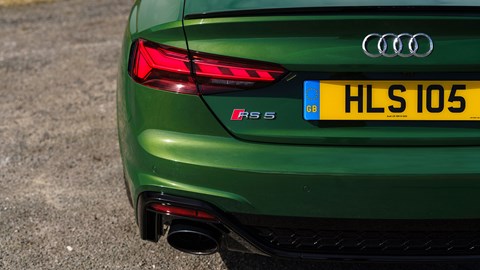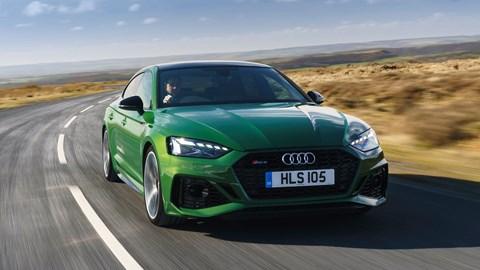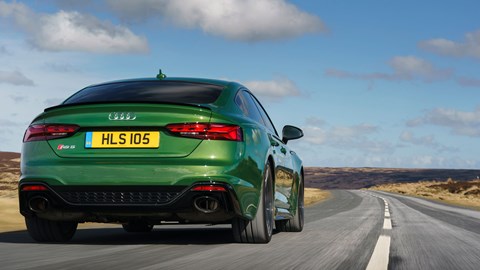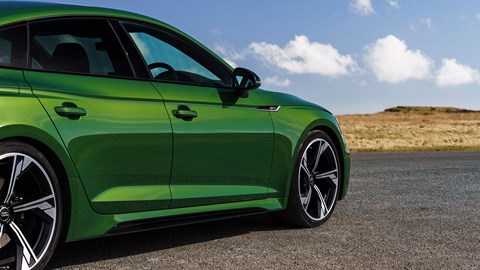► Audi isn’t giving up on fossil fuels just yet
► Brand will keep engines around until at least 2033
► Prepared for longer if legislation changes
Audi’s launched its replacement for the A5 and – shock horror – it’s powered by a range of petrol and diesel engines rather than batteries and electric motors. This is a bold move from a company which, just two short years ago, announced its plans to become an electric-only car manufacturer by 2029.
Audi also said it wouldn’t launch another dinosaur-burning model from 2026. But now, the company is poised to launch a range of brand-spanking new petrol and diesel cars, all of which it’ll be able to keep around until the European combustion car ban comes into force in 2035.

To reflect this shift in strategy, Audi has restructured its model range into two ‘columns.’ Now, Audi’s odd-numbered cars (such as the A5, Q5 and Q7) will feature combustion engines, while its even-numbered models (that’s the A4, A6 and Q6) will be propelled by batteries and electric motors.
I attended the preview event for the new Audi A5 and, to try and unearth why the brand has made such a dramatic U-turn, I seized the chance to quiz some of the company’s engineers. Scroll down to read through my findings.
So, why’s Audi had a change of heart?
Not all Audi’s customers are ready to make the switch to an electric vehicle. In fact, electric car sales are already dwindling amongst private buyers – and uptake in the leasing market is slow. Providers are amassing huge stockpiles of unwanted electric cars, which they’re having to flog at knockdown prices to clear space for fresher metal.
So, Audi has, rather pre-emptively, divvied up its eggs between two baskets. It’s adopted a two-platform strategy – one for each column. The brand’s zero-emission models will be built on its Premium Platform Electric (PPE) architecture, as found under the new Q6 e-tron, while its future fossil fuel cars will be propped up by its new Premium Platform Combustion architecture.
This latter chassis was designed specifically for use by Audi, and it’ll be complemented by a range of freshly developed petrol, diesel and hybrid powertrains – the former two of which are supported some snazzy new MHEV Plus technology. The brand also says it can extend or truncate the lifespans of either platform to adapt to changes in legislation and react to the needs of different markets.

Kerstin Englhardt, project leader for Audi’s PPC architecture, told me: ‘We still have combustion engines because we are convinced that we also need them for the future, for some markets. At the moment, our plan is to end it by 2033.
‘But, if we see in 2030, there’s new regulations in the European Parliament that [postpones] when we need to get out completely from the combustion engines and go over to the electric engines, we’re also thinking about running our combustion platform [for] longer.’
How long will Audi keep combustion engines around for?
By the sound of it, a very long time yet. In fact, Detlef Harzer, technical project manager for the new A5, reckons his new car has the potential to stick around right up until the 2035 deadline. I quizzed him about how the A5 would evolve between now and the combustion engine ban. He told me: ‘We are prepared to give [combustion engines] a longer life.
‘We are prepared for both columns. We will also see some law-driven development because there will be regions that can’t switch so fast – and we want to be prepared for both sides. It will be such a sliding process. But if it’s the last combustion car in the A5 model range, I couldn’t say.’
At that point, my ears pricked up. Harzer noticed my enthusiasm and followed up his statement by saying: ‘I think it will run longer than it’s planned.’

I immediately quizzed him about how the next, next generation version of the Audi A5 would look. Much like Volkswagen’s plans for extending the life of its petrol powered Golf GTI, Harzer told me Audi hopes to keep the A5 alive by launching a heavily updated version of the car that’ll break cover next week.
In essence, that means the new A5 will end up having two facelifts – one four years into its production cycle and one eight years in. That makes better financial sense for Audi than shovelling a truckload of cash at an all-new car that will, at best (providing the EU doesn’t do a handbrake turn on its eco-friendly motoring policies), only be on sale four years before legislation kills it.
How many cars will PPC underpin?
Audi’s still being rather coy about that, but it sounds like it’ll underpin all the combustion-powered cars from the A5 up. I asked Englhardt what the largest vehicle class is that’s being earmarked for PPC, to which she said: ‘I’m not sure if we can talk about that already but, yeah, up to our biggest cars.’
Allow me to translate. That’s evasive PR speak for ‘we’re building the next Q7 on it.’

Max Röhnlein, Audi’s technical project leader for engines, also explained how the PPC architecture has a lot of headroom in it. ‘The focus for Audi on that platform is also our lifecycle – to get more features in, to get more engines, or something like that. To be able to put in more functions for the customer.’
Röhnlein also hinted that Audi Sport isn’t giving up on combustion power, either, with both he and Englhardt confirming there’s a lot more performance to extract from PPC. Crucially, Englhart confirmed that the chassis is compatible with a V8 engine. So, watch this space, performance fans. Audi’s fire-spitting RS models might not be dead yet.